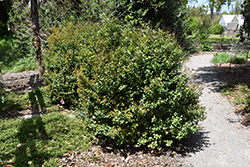Fri & Sat 8am - 8pm
Sun 8am - 7pm
Anytown, USA 12345
fax: 261.787.0463
e-mail: info@successgc.com


Plant Finder

Dwarf Simpson's Stopper
Myrcianthes fragrans 'Compacta'
Height: 5 feet
Spread: 4 feet
Sunlight:
![]()
![]()
Hardiness Zone: 9a
Other Names: Twinberry, form. Eugenia simpsonii
Description:
An excellent dwarf shrub with stiff branches and tiny rounded dark green leaves that emerge burgundy; white flowers bloom throughout spring and summer, followed by showy, edible berries; a great garden specimen or low hedge
Ornamental Features
Dwarf Simpson's Stopper is bathed in stunning panicles of fragrant white pincushion flowers at the ends of the branches from early spring to late summer. It has attractive dark green foliage with hints of coppery-bronze which emerges burgundy in spring. The tiny glossy oval leaves are highly ornamental and remain dark green throughout the winter. The fruits are showy red drupes with orange overtones and which fade to burgundy over time, which are carried in abundance from mid summer to early winter. The peeling brick red bark and brown branches add an interesting dimension to the landscape.
This plant is primarily grown as an ornamental, but it's also valued for its edible qualities. The small round tart fruit is most often used in the following ways:
- Preserves
Landscape Attributes
Dwarf Simpson's Stopper is a dense multi-stemmed evergreen shrub with an upright spreading habit of growth. Its relatively fine texture sets it apart from other landscape plants with less refined foliage.
This shrub will require occasional maintenance and upkeep, and should only be pruned after flowering to avoid removing any of the current season's flowers. It is a good choice for attracting birds, bees and butterflies to your yard. It has no significant negative characteristics.
Dwarf Simpson's Stopper is recommended for the following landscape applications;
- Accent
- Mass Planting
- Hedges/Screening
- General Garden Use
- Naturalizing And Woodland Gardens
- Container Planting
Planting & Growing
Dwarf Simpson's Stopper will grow to be about 5 feet tall at maturity, with a spread of 4 feet. It has a low canopy, and is suitable for planting under power lines. It grows at a slow rate, and under ideal conditions can be expected to live for 40 years or more. This is a self-pollinating variety, so it doesn't require a second plant nearby to set fruit.
This shrub does best in full sun to partial shade. It is very adaptable to both dry and moist growing conditions, but will not tolerate any standing water. It is considered to be drought-tolerant, and thus makes an ideal choice for xeriscaping or the moisture-conserving landscape. This plant will benefit from an application of bonemeal and/or mycorrhizal fertilizer at the time of planting. It is not particular as to soil pH, but grows best in sandy soils, and is able to handle environmental salt. It is somewhat tolerant of urban pollution. This is a selection of a native North American species. It can be propagated by cuttings; however, as a cultivated variety, be aware that it may be subject to certain restrictions or prohibitions on propagation.
Dwarf Simpson's Stopper makes a fine choice for the outdoor landscape, but it is also well-suited for use in outdoor pots and containers. With its upright habit of growth, it is best suited for use as a 'thriller' in the 'spiller-thriller-filler' container combination; plant it near the center of the pot, surrounded by smaller plants and those that spill over the edges. It is even sizeable enough that it can be grown alone in a suitable container. Note that when grown in a container, it may not perform exactly as indicated on the tag - this is to be expected. Also note that when growing plants in outdoor containers and baskets, they may require more frequent waterings than they would in the yard or garden.
